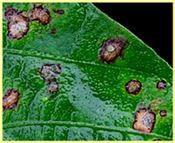2015 Soybean Re-Cap And Disease Update

DR. TREY PRICE, DR. CLAYTON HOLLIER AND DR. RONNIE LEVY
LSU AGCENTER
For the third year in a row, frogeye leaf spot (FLS) has been one of the most prevalent soybean diseases in the state. This is mostly due to the planting of susceptible varieties on large acreages. Frogeye leaf spot, at varying levels, can probably be found in every remaining field. Symptoms appear as small, circular chlorotic lesions with reddish to purple margins appearing on leaflets during reproductive stages (usually R4-R5) in the upper half of the canopy. If disease becomes severe, chlorotic/necrotic hot spots will develop in the field resulting in premature defoliation. The disease also may develop on pods, petioles, and stems if heavy infection has occurred. FLS will progress slowly, but steadily, during periods of hot and dry weather. Faster disease progression should be expected during rainy conditions.
FLS infection may require fungicide applications for management depending on disease severity, crop stage, and prevailing environmental conditions. It is important to keep in mind that soybeans can tolerate a considerable amount of leaf area loss before a significant yield loss is realized (A good rule of thumb is 20 percent and 30 percent at R5 and R6, respectively). If you have a susceptible variety, scouting is key for management. Instead of making a fungicide application at the first sign of disease, a reactionary approach should be implemented. If FLS is relatively light, mark leaflets in the field using spray paint or flagging then estimate disease severity (please see the rating scale from the July issue of this newsletter). Come back a week later and estimate disease severity on the same leaflets. If an application is not warranted, give it another week, and so on. You may be able to avoid or reduce the number of fungicide applications for management using this tactic. If an application is deemed necessary, there are many triazole fungicides available that are effective at slowing disease development and preserving yield. Some triazoles may be more effective than others, so contact your nearest specialist for more information.
Resistant varieties often will develop very light, insignificant levels of FLS. Therefore, fungicide applications are not necessary in these situations, making it extremely important to document and remember which variety was planted and where each variety was planted. THIS CAN SAVE YOUR OPERATION MONEY. Fungicides are not cheap, and choosing resistant varieties can be a cost-effective management strategy. Every year, LSU AgCenter scientists plant soybean variety trials, and these trials are rated for naturally-occurring diseases in many locations throughout the state. When choosing varieties, be sure to use official variety trial results from the location nearest your farm. Preliminary results of LSU AgCenter OVT disease ratings are included in this newsletter.
Cercospora leaf blight (CLB) also is an annual problem in Louisiana and seems to be more prevalent this year than in 2014. Symptoms first appear near R5 as reddening or purpling of petioles with leaves in the upper portion of the canopy displaying a leathery appearance quickly followed by bronzing or purpling. Severe infections may result in defoliation of plants beginning at the top of the canopy progressing downward. Other issues that may be mistaken for CLB include: alfalfa hopper damage, dectes stem borer damage, environmental stresses, natural varietal characteristics, natural senescence, nutrient imbalance, or herbicide damage
Unfortunately, there are currently no fungicides that are consistently effective on CLB. Varieties that are planted earlier seem to escape or have low CLB levels. Some varieties may be somewhat tolerant in a given area; therefore, choosing varieties based on ratings nearest your farm is very important.
Soybean rust has been found at low levels on soybean in East Baton Rouge, Iberia, Lafourche, Rapides, Terrebonne, and Washington parishes in the state. The disease will first appear in the lower canopy as tan to reddish angular lesions. Lesions also may appear on pods, petioles, and stems. Closer inspection of the underside of leaflets with a hand lens will reveal spores produced by the pathogen. Soybean rust may be easily confused with bacterial pustule.
Since the disease has arrived late this growing season, progression to damaging levels is unlikely. However, late-planted soybean should be monitored for infection. There are many fungicides available for managing soybean rust if applications become necessary.
For more information, please do not hesitate to contact your nearest county agent, specialist, or research station. ∆
DR. TREY PRICE: Assistant Professor, LSU AgCenter
DR. CLAYTON HOLLIER: Professor, LSU AgCenter
DR. RONNIE LEVY: Associate Professor & Soybean Specialist, LSU AgCenter